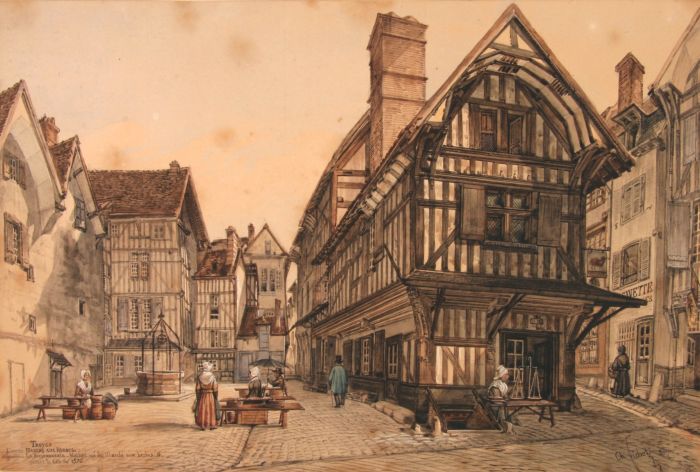Troyes
| Address |
|---|
|
Les Foires de Champagne au Moyen-Age |
The Champagne Fairs and Saint-Jean-au-Marché district
It is mainly in the urban fabric that the memory of the great Champagne Fairs can be found, fairs that were held in the city of Troyes during the festival of Saint-Vincent (9-15 July), and Saint Remi (1st or 2nd November). The confusion of streets and small squares with closed courtyards give an idea of the city at this period.
Certain street names – that haven’t changed since the Middle Ages – would even be familiar to the merchants of the time, such as “la rue de la Montée des Changes”, “la rue Champeaux”, “la rue de la Pierre” and “la rue des Anciennes Tanneries”, all evoking things as they were at that time, and the merchants would doubtless recognise the silhouette of the Troyes houses rebuilt identically in the 16 c. with their corbelled roofs and their mullioned windows and their timber and cob walls, materials commonly used in mediaeval architecture in the Champagne region.
The majority of these houses have kept their cellars and their vaults, some on two levels were probably used by merchants and drapers.
From XII and XIII c., there are also elements of sacred architecture, demonstrating the fervour and faith of these men. There is much evidence of the donations of prosperous merchants. In the courtyard in the quarter of the Fairs, the nave of the Saint Jean-au-Marché church, the tower of the Saint Rémi church and a large part of the church of Sainte Madeleine, the Saint Urbain basilica (1262-1286) and its stained glass windows mark the whole of this period. Started before the end of the XII c., the Cathedral continued to be built during the following century. Some of its glass is from this period along with its treasure in which there is a fine collection of Limousin and Mosan enamels from the XII and XIII c.
During the Great Fairs, Troyes was a formidable place for commercial exchanges and also a meeting place where men’s ideas were encountered. This intellectual effervescence can be measured partly through their written records in the ancient stores of the Troyes library. This library also houses the library of Count Henry 1st the Liberal and his wife, Marie de Champagne, the first princely French library within knowledge since Charlemagne...
In the Middle Ages the Counts of Champagne encouraged the prosperity of commercial exchanges; they instituted rules concerning the manner in which the fairs were to be conducted and the policing of the markets, ensuring the safety of the travellers, the traders and the good faith of the operations carried out, with six great fairs spread over a whole year: 2 at Provins, 1 at Lagny, 1 at Bar-sur-Aube and 2 very large ones at Troyes (the St Jean Hot Fair and the St Rémi Cold Fair).
Money-changers and bankers played an important role, since only the money of the Counts and the King was allowed. The Counts also protected the Jewish community, where RACHI came from. The Saint-Jean-au-Marché church was the centre of the Fairs quarter. Certain street still have evocative names, Rue de la Montée des Changes, Place du Marché au Pain.
These fairs were the meeting place for the whole of the Western world: there were Flemish, English and Spanish wools, silks, leathers, furs, spices, precious woods and gold and silver wares.
Last updated on 02/10/2020 - Troyes La Champagne Tourisme

